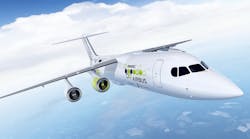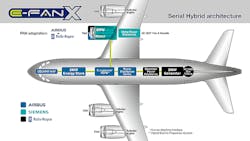Airbus, Rolls-Royce, and Siemens are jointly developing a hybrid-electric propulsion system for commercial aircraft, working to have a demonstrator craft in flight by 2020. A demonstrator take-off for their E-Fan X technology would be preceded by ground testing on a BAe 146 flying testbed, with one of the aircraft’s four gas turbine engines replaced by a two-megawatt electric motor. Once that technology has been “matured,” a second gas turbine would be replaced with an electric motor.
While the issue of carbon emissions is an important concern for commercial airlines and aircraft builders, there are no viable alternatives to jet-fueled turboshaft propulsion: electric power is unfeasible because of the weight of battery fuel cells; and biofuel engine developments have yet to prove safe or effective.
Even so, the European Union is pressuring the carriers and OEMs to cut aircraft CO2 emissions by 75%, NOx by 90%, and to reduce aircraft noise by 65%, all of this by 2050.
The hybrid approach suggested by E-Fan X may be a new route. The concept involves a turboshaft engine running on jet fuel, powering a generator that fuels an electric engine -- and stores surplus energy in a series of batteries that provide reserve power for take-offs and landings.
The demonstrator program will research the problems presented with high-power propulsion systems, including thermal effects, electric thrust management, altitude and dynamic effects on electric systems, and electromagnetic compatibility issues.
The E-Fan X program also seeks to define the requirements for future certification of electrically powered aircraft, and to train designers and engineers to understand and develop future hybrid-electric commercial aircraft systems.
“We see hybrid-electric propulsion as a compelling technology for the future of aviation,” according to Paul Eremenko, the Airbus chief technology officer.
In their partnership, Airbus will be responsible for overall integration of the aircraft design, as well as control architecture for the hybrid-electric propulsion system and batteries, and integrating these with flight controls.
Rolls-Royce will be responsible for designing a turboshaft engine, a 2-MW generator, and power electronics. Rolls-Royce also will work with Airbus to adapt the fan to the existing nacelle design and a Siemens electric motor.
Siemens will provide the 2-MW electric motors and power electronic control units, as well as the inverter, DC/DC converter, and power distribution system. (Airbus and Siemens have been working together since last year on the E-Aircraft Systems House, which seeks to develop, test, and mature electric propulsion system components across various power classes.)
“The E-Fan X enables us to build on our wealth of electrical expertise to revolutionize flight and welcome in the third generation of aviation,” offered Rolls-Royce CTO Paul Stein.







